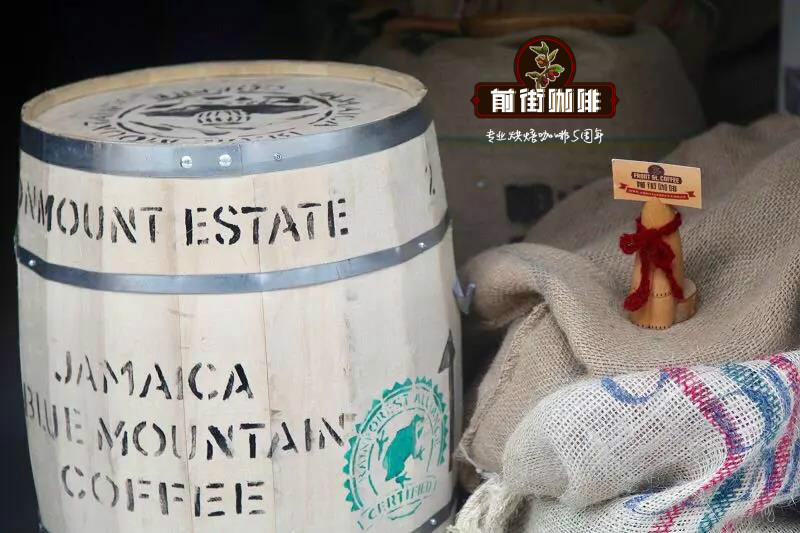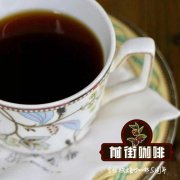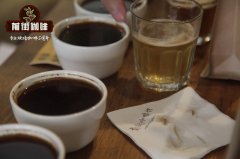Knowledge of Jamaican coffee beans: why is Blue Mountain coffee filled in wooden buckets?

Professional coffee knowledge exchange more coffee bean information please follow the coffee workshop (Wechat official account cafe_style)
Blue Mountain Coffee is a coffee bean brand grown in a limited area of the Blue Mountain Mountains of Jamaica at an altitude of 800-1200 meters. It usually grows on steep slopes, sometimes as high as 60 degrees and requires manual mining. It is characterized by its high aroma and delicate taste. Because of its high aroma, it is often mixed with other raw beans and more than 80% of it is exported to Japan.
Output is scarce
Because it is only planted in limited areas, the harvest is very low. The output of raw beans in 2014 was about 875 metric tons. July 2013-July 2014, the amount of raw beans exported by Jamaica to Japan was 283 tons, plus 440 metric tons * 2. The total is 723 tons. After baking, 578 tons of ripe beans will be produced. Taking 15 grams as a cup, about 38.56 million cups, the average person in Japan drinks less than one cup of Blue Mountain coffee in a year. In fact, Blue Mountain coffee beans are the same as other coffee beans grown in Jamaica, but because they are cultivated in a harsh environment and screened through strict inspection, they produce a very meticulous taste. In 1953, the Jamaican government drew a clear line between the Blue Mountains and other areas in accordance with the law, stipulating that the name of Blue Mountain Coffee should not be used for coffee in areas other than the Blue Mountains. Only coffee made in selected areas of the Blue Mountains can be called "Blue Mountain Coffee".
The origin of the barrel:
Of all the coffee, only Blue Mountain Coffee is in buckets, and other coffee exits are in sacks. It is said that from the mid-18th century, flour shipped from England to Jamaica during the British colonial period was recycled in empty buckets and used to transport coffee and rum. The buckets used today are all wood from temperate forests in the United States. the advantage of buckets is to absorb and release internal and external humidity without much change, which can alleviate sudden temperature changes in the process of transportation. Another barrel sealed off coffee aroma, can maintain the best coffee quality, but the additional cost will be higher.
Brand marketing strategy
In 1936, more than 80% of Jamaican Blue Mountain coffee was sold to Japan, and Japanese trading houses used the slogan "British Royal use" as an advertising slogan. Jamaica was a British territory at that time, and it was taken for granted by the Japanese public that Jamaican coffee was also drunk by the "British royal family". In fact, it was groundless. However, because the publicity activities in Japan are very large and sell very well, this myth has been handed down in Japan so far.
Originally in the "Blue Mountain Mountains" 800-1200 meters away from a specific area, using the name "Blue Mountain" is not allowed. However, the domestic sales volume of Blue Mountain imported into Japan is three times that of normal imports. Many of the coffee is grown at an altitude of 800 meters or less, but it is often named Blue Mountain. Even so, the price of raw coffee beans is between 4000 yen and 5000 yen per kilogram (the market price in 2013), which is very expensive. There are only a few cafes in Japan that put some blue mountain coffee beans to meet their customers.
In 1953, the Jamaican government established the Jamaican Coffee Authority (Coffee Industry Board, referred to as CIB) to manage the quality of Jamaican coffee. Jamaica is the first country in the world to distinguish coffee names on a regional basis. Like French wine, cheese, cream, etc., will be named after the country of origin. All coffee exported from Jamaica can only be exported through the Jamaican Coffee. In particular, coffee harvested from the Blue Mountain area authorized by law is absolutely 100% Blue Mountain coffee.
It is well known that the Classdale area is located in St. Andrew's diocese, where coffee is produced at an average altitude of 1000 meters, which is right in the middle of Blue Mountain coffee production. Therefore, it is also called "the Heart of the Blue Mountain". Near this area is the largest national park in the country, as well as the Grand Ridge Forest Reserve.
The history of Clydesdale
Classdale Manor was founded by Dr. Colin McClarty in England in 1800. Although he first went to Jamaica for the purpose of a trip, he fell in love with the land and settled down. The estate was also one of the first estates to commercialize Jamaican coffee. At that time, the name of the diocese was still Port Royal, but it was later changed to St. Andrew's diocese. Farmers began to find that the coffee produced in the area was of good quality, so they followed Dr. McClarty and started growing coffee near Clydesdale. In this way, Coffee is growing more and more widely in Clydesdale. Coffee from Clydesdale Manor has been exported since the 1800s.
Although Clydesdale Manor is no longer in actual operation, the treatment plant, drying plant and water wheel at that time are still in good condition 200 years later. Clydesdale Great House, once a honeymoon accommodation and adjacent to the factory, has also been designated as a national heritage by the Jamaican government.
Producers in the Clersdale area continue to grow good tin card coffee. Clydesdale is the blue mountain coffee harvested in this area. Irreplaceable and incomparable, this fragrance remains the same today.
Producing country Jamaica
Regional St. Andrew Parish Clifton Mount and Clydesdale
Producers of Clifton Mount and Clydesdale in St. Andrew's diocese.
Specification NO.1
The defect specification is 3% less than full.
The visual size is 17 stroke 18 mesh.
Planting variety iron pickup
Other elevations: 1000m--1250m solar drying and mechanical drying
Treatment: washing
Flowering period from January to May
Harvest time from January to February
Storage method constant temperature warehouse
How to roast to show the better flavor of Jamaican Blue Mountain Coffee?
Qianjie Coffee believes that Blue Mountain Coffee is roasted "thoroughly" from the inside to the outside, and better roasting techniques are used on the basis of roasting to show the flavor of Blue Mountain Coffee.
Caramelization is a link that has the greatest impact on the flavor of coffee. After six to seven minutes of baking, raw beans absorb a lot of heat and start the pyrolysis reaction, resulting in the first explosive sound. Some sugars are converted into carbon dioxide, and water continues to evaporate. New aromatic components gradually develop into the so-called coffee oil. And combine with hundreds of aromatic substances such as nicotinic acid, citric acid, quinic acid, malic acid, acetic acid, caffeine and so on.
Baking curve: furnace temperature to 170 degrees Celsius, throttle set for 1 minute, firepower 140 degrees, throttle unchanged, baking to 5 degrees Celsius 39 degrees 10 ", temperature 153 degrees, bean surface turns yellow, grass smell disappears completely, dehydration is completed, firepower is adjusted to 115 degrees, throttle changes 4".
In the 8th & # 39th minute, ugly wrinkles and black markings appear on the bean surface, and the smell of toast obviously changes to the smell of coffee, which can be defined as a prelude to explosion. at this time, listen clearly to the sound of an explosion point, and start to explode at 8 degrees 39 ". Adjust the firepower to 90 degrees, the throttle is fully open (adjust the firepower to be very careful, not to be so small as to be free of bursting sound), and put the pot at 201.3 degrees.
Qianjie Coffee is recommended to brew Blue Mountain Coffee at a lower water temperature of 86-88 degrees. Use a KONO filter cup to enhance its mellow taste. The entrance is the bitterness of chocolate, caramel sweetness is obvious, with some low acidity.
Related recommendations: Jamaica Blue Mountain hand flushing suggestion, temperature, grinding degree, powder-water ratio to introduce flavor and taste description
Important Notice :
前街咖啡 FrontStreet Coffee has moved to new addredd:
FrontStreet Coffee Address: 315,Donghua East Road,GuangZhou
Tel:020 38364473
- Prev

Take Yunnan coffee as an example: find the coffee taste that suits you from the method of treatment.
Professional coffee knowledge exchange more coffee bean information please pay attention to the coffee workshop (Wechat official account cafe_style) coffee fresh fruit harvest, take Yunnan as an example, three harvest periods: the end of October to mid-December for early ripening fruit, less yield; mid-December to the end of January for the concentrated ripening period of coffee fruit, the overall quality of this batch of coffee is the best; the rest of February is mostly diseased fruit, producing
- Next

Truth about Jamaican Coffee: are Blue Mountain Coffee beans the same as Blue Mountain Coffee?
Professional coffee knowledge exchange more coffee bean information please follow the coffee workshop (Wechat official account cafe_style) Blue Mountain Coffee beans and Blue Mountain Coffee have the same meaning? What is Jamaican Blue Mountain Coffee? Blue Mountain Coffee comes from the Blue Mountains region of Jamaica in the West Indies (geographically blind note: the West Indies are not in India but in the Caribbean). But not all Blue Mountains.
Related
- Beginners will see the "Coffee pull flower" guide!
- What is the difference between ice blog purified milk and ordinary milk coffee?
- Why is the Philippines the largest producer of crops in Liberia?
- For coffee extraction, should the fine powder be retained?
- How does extracted espresso fill pressed powder? How much strength does it take to press the powder?
- How to make jasmine cold extract coffee? Is the jasmine + latte good?
- Will this little toy really make the coffee taste better? How does Lily Drip affect coffee extraction?
- Will the action of slapping the filter cup also affect coffee extraction?
- What's the difference between powder-to-water ratio and powder-to-liquid ratio?
- What is the Ethiopian local species? What does it have to do with Heirloom native species?

